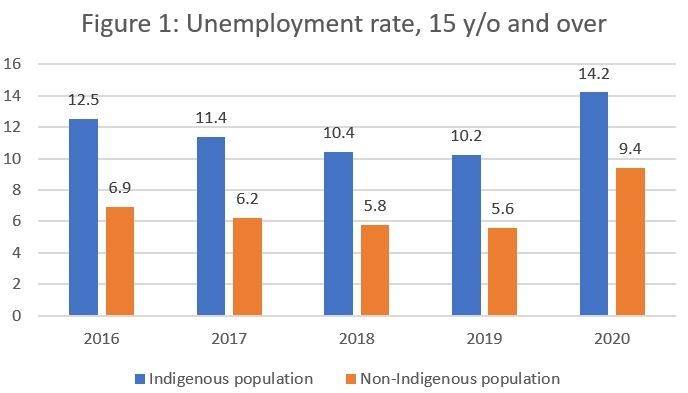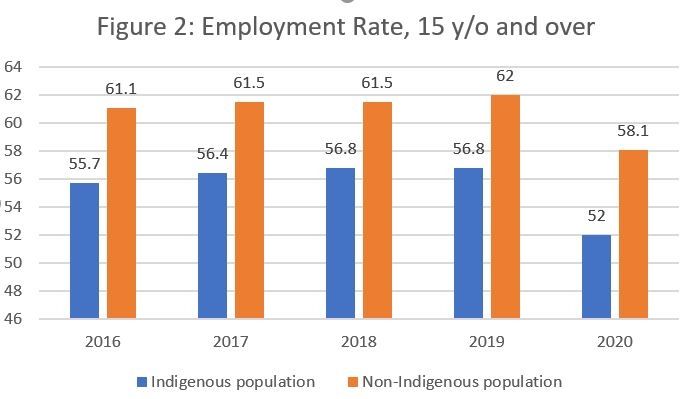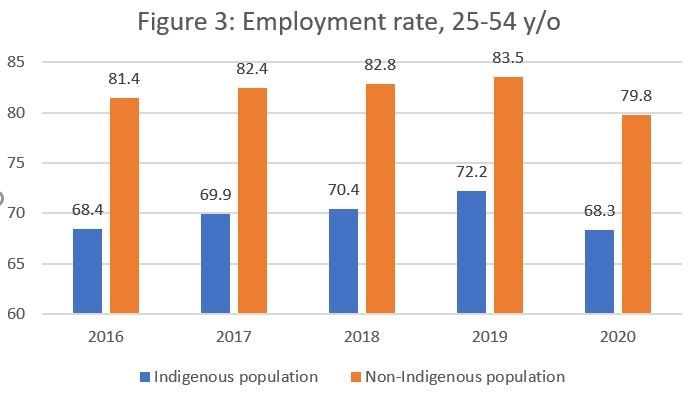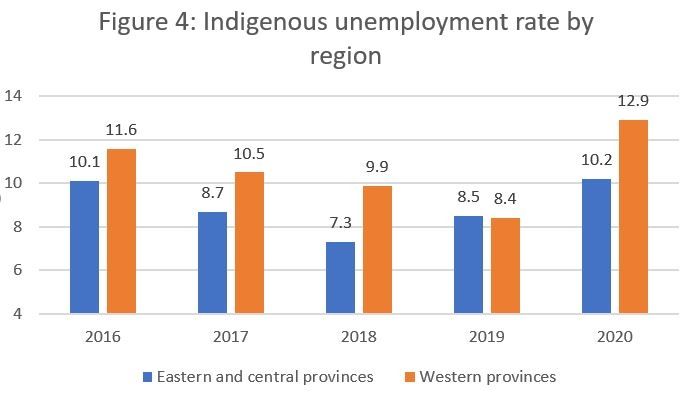
Share
As Unifor marks National Indigenous Peoples Day and we come together to celebrate the heritage and history of the first peoples of this land, our thoughts turn to the continuing barriers that Indigenous people face in Canada due to structural racism and the violent and ongoing legacies of settler colonialism.
In this supplementary post to our monthly Labour Market Insights, we take a detailed look at how Indigenous people have fared in the labour market during the COVID-19 pandemic and highlight some of the main challenges confronting Indigenous workers across the country.
As Figure 1 illustrates, the unemployment rate for Indigenous people has been consistently higher than non-Indigenous people, although the gap had been slowly declining from 2016 until 2019. During 2020, however, the Indigenous unemployment rate spiked to more than 14 per cent, 4.8 percentage points higher than the non-Indigenous unemployment rate.
Figure 2 reveals that the gap was even greater if we compare the employment rate between Indigenous and non-Indigenous people, suggesting that a greater percentage of Indigenous workers left the labour market entirely. While the employment rate gap had been trimmed down to 4.7 percentage points in 2018, the economic impacts of the COVID-19 pandemic hit Indigenous communities significantly harder. As a result, the Indigenous employment rate plummeted to 52 per cent in 2020, 6.1 percentage points lower than the non-Indigenous population. This gap was higher for Indigenous men (-7.5 percentage points) than women (-4.5 percentage points).
In fact, the employment rate gap was even more pronounced for core-aged workers between 25 and 54 years of age, with the gap rising to 11.5 percentage points in 2020 (see Figure 3). A smaller employment rate gap between Indigenous and non-Indigenous youths aged 15 to 24 (44.7% for Indigenous youth compared to 49.7% for non-Indigenous youth in 2020) partially helped to offset the significantly greater employment gap experienced by core-aged Indigenous workers.
On average, Indigenous workers worked slightly more hours per week in 2020 compared to non-Indigenous workers but made $2.78 per hour less, a difference of approximately 10% (see Table 1).
|
Table 1: Wages and weekly hours |
Indigenous |
Non-Indigenous |
|
Average hourly wage |
$26.81 |
$29.59 |
|
Average weekly hours |
35.7 |
35.5 |
These numbers are reflected in the more precarious, low-paid and labour-intensive kinds of jobs that Indigenous workers are concentrated in. As Table 2 reveals, there is an over-representation of Indigenous workers in sales and services occupations as well as in traditional blue-collar jobs in the trades, natural resources, manufacturing and utilities, etc.
|
Table 2: Share of population by occupation category |
Indigenous |
Non-Indigenous |
|
Management, business, finance and administration occupations |
21.18% |
26.05% |
|
Natural and applied sciences; health; education, law and social, community and government services; art, culture, recreation and sport |
25.77% |
31.37% |
|
Sales and service occupations |
26.31% |
22.20% |
|
Trades, transport and equipment operators; natural resources, agriculture and related production; manufacturing and utilities |
26.74% |
20.38% |
Finally, Figure 4 indicates that labour market outcomes for Indigenous people were unevenly distributed across the country, with those in the western provinces (BC, Alberta, Saskatchewan and Manitoba) tending to fare worse than those in the central and eastern provinces (Ontario, Quebec, New Brunswick, Nova Scotia, Newfoundland and Labrador, and PEI).
As the country continues to be gripped by the horrific discovery of the remains of 215 Indigenous children who had been students at one of Canada’s largest residential schools, we must never forget that the terrible legacies of settler colonial violence and the residential school system continue to manifest themselves in the structural discrimination and labour market barriers that Indigenous workers confront today.







